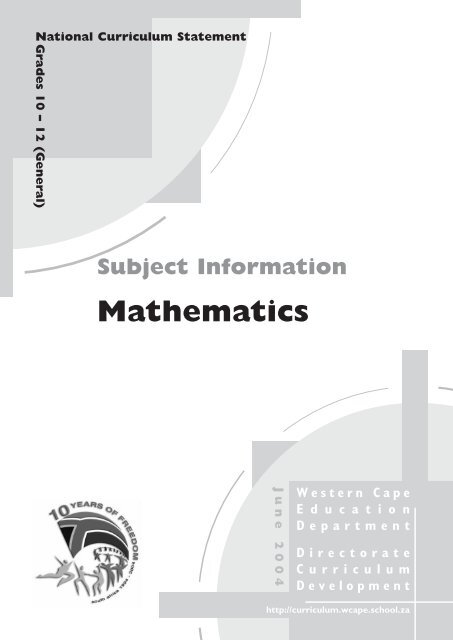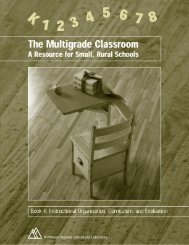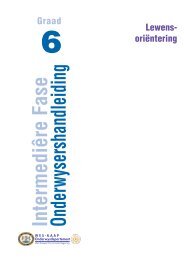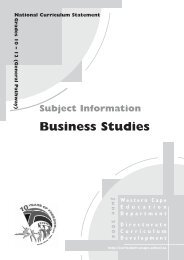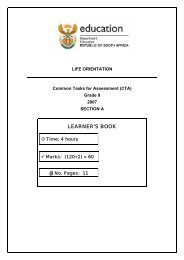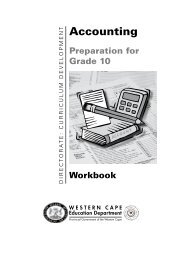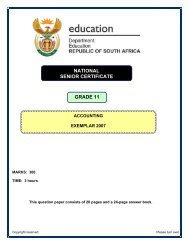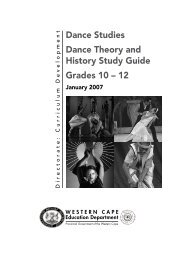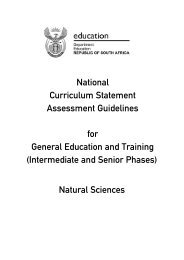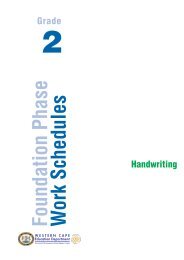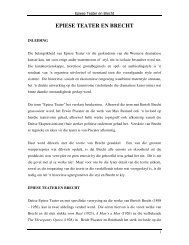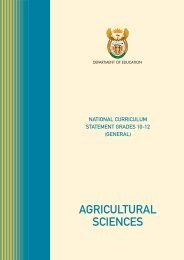Mathematics - Curriculum Development
Mathematics - Curriculum Development
Mathematics - Curriculum Development
Create successful ePaper yourself
Turn your PDF publications into a flip-book with our unique Google optimized e-Paper software.
National <strong>Curriculum</strong> Statement<br />
Grades 10 – 12 (General)<br />
Subject Information<br />
<strong>Mathematics</strong><br />
June 2004<br />
Western Cape<br />
E d u c a t i o n<br />
Department<br />
Directorate<br />
<strong>Curriculum</strong><br />
<strong>Development</strong><br />
http://curriculum.wcape.school.za
Wes-Kaap Ondewysdepartement<br />
Western Cape Education Department<br />
ISebe leMfundo leNtshona Koloni<br />
Subject Information<br />
<strong>Mathematics</strong><br />
Table of Contents<br />
FOREWORD . . . . . . . . . . . . . . . . . . . . . . . . . . . . . . . . . . . . . . . . . . . . . . . . . . . . . . . . . . 1<br />
THE NATIONAL CURRICULUM STATEMENT (NCS) . . . . . . . . . . . . . . . . . . . . . . . 1<br />
LEARNING FIELDS . . . . . . . . . . . . . . . . . . . . . . . . . . . . . . . . . . . . . . . . . . . . . . . . . . . . 2<br />
RULES OF COMBINATION FOR FETC . . . . . . . . . . . . . . . . . . . . . . . . . . . . . . . . . . . 2<br />
SUBJECT OVERVIEW . . . . . . . . . . . . . . . . . . . . . . . . . . . . . . . . . . . . . . . . . . . . . . . . . . 2<br />
WHAT IS MATHEMATICS . . . . . . . . . . . . . . . . . . . . . . . . . . . . . . . . . . . . . . . . . . . . . . 2<br />
PURPOSE. . . . . . . . . . . . . . . . . . . . . . . . . . . . . . . . . . . . . . . . . . . . . . . . . . . . . . . . . . . . . 2<br />
SCOPE . . . . . . . . . . . . . . . . . . . . . . . . . . . . . . . . . . . . . . . . . . . . . . . . . . . . . . . . . . . . . . . 3<br />
EDUCATIONAL AND CAREER LINKS . . . . . . . . . . . . . . . . . . . . . . . . . . . . . . . . . . . . 3<br />
LEARNING OUTCOMES. . . . . . . . . . . . . . . . . . . . . . . . . . . . . . . . . . . . . . . . . . . . . . . . 3<br />
ASSESSMENT STANDARDS. . . . . . . . . . . . . . . . . . . . . . . . . . . . . . . . . . . . . . . . . . . . . 3<br />
CONTENT AND CONTEXTS . . . . . . . . . . . . . . . . . . . . . . . . . . . . . . . . . . . . . . . . . . . 4<br />
ICT LINKS . . . . . . . . . . . . . . . . . . . . . . . . . . . . . . . . . . . . . . . . . . . . . . . . . . . . . . . . . . . . 5<br />
REFERENCES . . . . . . . . . . . . . . . . . . . . . . . . . . . . . . . . . . . . . . . . . . . . . . . . . . . . . . . . . 6
Foreword<br />
The National <strong>Curriculum</strong> Statement Grades 10 – 12 (General) represents a policy statement for learning<br />
and teaching in schools in the Further Education and Training Band. It aims to provide a transformational<br />
curriculum that focuses on high knowledge and skills.<br />
This guideline provides a quick overview of the National <strong>Curriculum</strong> Statement.<br />
It offers cross-referencing to the Further Education and Training Policy For Grades 10 – 12 (General) Overview<br />
and the Qualifications and Assessment Policy Framework Grades 10 – 12 (General) (see Overview and subject<br />
statement links with FET NCS policy, on page 4 of this guide)<br />
Teachers should use this guideline as a tool to navigate the subject policy statement.The various sections<br />
in the subject policy statement are cross-referenced by providing the relevant page numbers from the<br />
related policy document(s).<br />
The infusion of ICT into the implementation of the NCS is focussed at both teacher development and<br />
classroom practice.These guidelines therefore provide a brief overview of this exciting medium in terms<br />
of curriculum delivery, including teaching, learning and assessment.<br />
To conclude it must be noted that this subject statement guide serves as a first step in the preparation of<br />
teachers for the implementation the NCS in their own classrooms.Teachers are encouraged to study this<br />
guide as well as the Subject Policy Statement in preparation for the training events of 2005.<br />
THE NATIONAL CURRICULUM STATEMENT (NCS)<br />
The NCS Grades 10 – 12 (General) consist of three policy documents, which should be read<br />
together.These documents are:<br />
1. Overview<br />
This document provides an overall introduction to the NCS. It describes the philosophical underpinnings<br />
of the curriculum and explains the reasons for change. It also summarises the main issues related to<br />
inclusive education and assessment.<br />
2. Qualification and Assessment Policy Framework<br />
This document aims to provide a mechanism through which you assess the attainment of the learning<br />
outcomes. It outlines the requirements and the rules for the award of the Further Education and Training<br />
Certificate (FETC).<br />
3. Subject Statement<br />
The third pillar of the NCS comprises subject statements. Each containing:<br />
• Definition<br />
• Purpose<br />
• Scope<br />
• Education and Career Links<br />
• Learning Outcomes<br />
• Assessment Standards<br />
• Competence Descriptions per grade<br />
• Content and Contexts for attaining the assessment standards<br />
• A generic section on assessment.<br />
It is important that teachers realise that these documents are interrelated and should be read in<br />
conjunction.<br />
National <strong>Curriculum</strong> Statement 1 <strong>Mathematics</strong><br />
Grades 10 – 12 (General)
Learning Fields<br />
Six Learning Fields<br />
(See NCS Overview, page 12)<br />
(See Qualifications & Assessment Policy Framework, page 13 – 14)<br />
• Languages (Fundamental)<br />
• Arts & Culture<br />
• Human and Social Studies and Languages<br />
• Physical, Mathematical, Computer, Life and Agricultural Sciences<br />
• Business, Commerce, Management and Service studies<br />
• Manufacturing, Engineering and Technology<br />
Rules of Combination for FETC<br />
(Refer to Qualifications and Assessment Policy Framework pp 15 – 17)<br />
Fundamental Core Elective<br />
Home Language (20)<br />
(4,5 hours per week)<br />
Home Language /<br />
1st Add Language (20)<br />
(4,5 hours per week)<br />
<strong>Mathematics</strong>/<br />
Maths Literacy (20)<br />
(5 hours per week)<br />
Life Orientation (10)<br />
(2 hours per week)<br />
2 subjects from<br />
one Field<br />
(2 x 20)<br />
(2 x 4,5 hours per week)<br />
1 subject from the same<br />
or a different Field<br />
(1x 20)<br />
(1 x 4,5 hours per week)<br />
70 credits 40 credits 20 credits<br />
SUBJECT OVERVIEW<br />
WHAT IS MATHEMATICS<br />
See Subject Statement, page 9<br />
We will not define mathematics but describe what informs our view of the subject. It is a human activity<br />
practised by all cultures. Knowledge in the subject is constructed as a result of observing patterns and<br />
formulating theories using rigorous logical thinking.This is done through the establishment of descriptive,<br />
numerical and symbolic relationships. <strong>Mathematics</strong> is developed and contested over time through both<br />
language and symbols and by social interaction and is thus open to change.<br />
Purpose<br />
See Subject Statement page 9<br />
<strong>Mathematics</strong> enables creative and logical reasoning about problems in the physical and social world as<br />
well as in the context of the subject itself. Mathematical problem solving enables us to understand the<br />
world and make use of that understanding in our daily lives. It also provides access to further study in<br />
various fields such as the sciences and engineering as well as a variety of career paths.<br />
<strong>Mathematics</strong> 2 National <strong>Curriculum</strong> Statement<br />
Grades 10 – 12 (General)
Scope<br />
See Subject Statement page 10<br />
Learners exiting the FET band will develop competence in the use of mathematical process skills in the<br />
context of Numbers and Algebra, Geometry (including the techniques of trigonometry and co-ordinate<br />
and transformational geometry), and Measurement, Data Handling and Probability.This includes:<br />
• Critically investigate and monitor the financial aspects of personal and community life<br />
• Produce useful equivalents for algebraic expressions and mathematical models<br />
• Describe, represent and analyse shape and space in two and three dimensions<br />
• Collect and use data to establish statistical and probability models<br />
• Use and understand the principles of differential calculus and solve simple optimisation problems<br />
• Investigate the historical aspects of the development o and use of <strong>Mathematics</strong> in various cultures<br />
• Use available technology in calculations and in the development of mathematical models<br />
Educational and Career Links<br />
See Subject Statement page 11<br />
<strong>Mathematics</strong> is vital for any learner who wishes to pursue a career in the Physical, mathematical,<br />
Computer, life, earth, Space and environmental sciences. <strong>Mathematics</strong> also supports careers in the<br />
economic, management and social sciences. <strong>Mathematics</strong> in the FET band will provide a basis for further<br />
Mathematical studies at tertiary institutions. Mathematical habits of mind is also an essential component<br />
for success in the workplace<br />
NOTE: If a learner does not perceive mathematics to be essential for their chooses career path or<br />
further study he/she may choose Mathematical Literacy.<br />
Learning Outcomes<br />
See Subject Statement page 12 – 14<br />
LO 1: Number and Number Relationships<br />
When solving problems the learner is able to recognise, describe, represent and work confidently with<br />
numbers and their relationships to estimate, calculate and check solutions.<br />
LO 2: Functions and Algebra<br />
The learner is able to investigate, analyse, describe and represent a wide range of functions and solve<br />
related problems.<br />
LO 3: Space, Shape and Measurement<br />
The learner is able to describe, represent, analyse and explain properties of shapes in 2-dimensional and<br />
3-dimensional space with justification.<br />
LO 4: Data Handling and Probability<br />
The learner is able to collect, organise, analyse and interpret data to establish statistical and probability<br />
models and to solve related problems.<br />
Assessment Standards<br />
See Subject Statement page 16 – 38<br />
Assessment standards are written per grade for each learning outcome, thus indicating conceptual<br />
progression from grade to grade.They embody knowledge, skills and values required to achieve the LOs.<br />
In this sense they provide criteria of what the learners should know and demonstrate at a specific grade.<br />
National <strong>Curriculum</strong> Statement 3 <strong>Mathematics</strong><br />
Grades 10 – 12 (General)
CONTENT AND CONTEXTS<br />
See Subject Statement, page 44 – 62<br />
Summary of content for <strong>Mathematics</strong><br />
GRADE 10 GRADE 11 GRADE 12<br />
LO 1 • Recurring and terminating decimals<br />
• Laws of exponents (integral exp.)<br />
• Rational approximation of surds<br />
• Number patterns (linear)<br />
• Simple and compound growth<br />
• Foreign exchange rates<br />
LO 2 • Study of different functions<br />
• Conversion between numerical,<br />
graphical, verbal and symbolic<br />
representations<br />
• Investigating the effect of different<br />
parameters<br />
• Sketchgraphs using properties of<br />
functions<br />
• Algebraic manipulations<br />
• Solution of equations and<br />
inequalities<br />
• Average rate of change<br />
LO 3 • Effect on volume and surface area<br />
when changing linear dimensions<br />
• Investigation of polygons<br />
• Co-ordinate geometry (points)<br />
• Transformation Geometry<br />
• Trigonometry<br />
• Historical development of geometry<br />
and trigonometry (research)<br />
LO 4 • Data Handling (calculations):<br />
• Measures of central tendency<br />
• Measures of dispersion<br />
• Errors in measurement<br />
• Data Handling(Representations):<br />
• Bar and compound bar graphs<br />
• Histograms and frequency polygons<br />
• Pie charts<br />
• Line and broken-line graphs<br />
• Probability:<br />
• Definition<br />
• Relative frequency<br />
• Venn diagrams<br />
• Mutually exclusive events<br />
• Complementary events<br />
• Potential uses and misuses of<br />
statistics and charts<br />
• Recognition of non-real numbers<br />
• Laws of exponents (rational exp.)<br />
• Operations with simple surds<br />
• Error margins<br />
• Number patterns (quadratic)<br />
• Simple and compound decay<br />
• Different periods of compounding<br />
growth and decay<br />
• Study of different functions<br />
• Conversion between numerical,<br />
graphical, verbal and symbolic<br />
representations<br />
• Investigating the effect of different<br />
parameters<br />
• Sketchgraphs using properties of<br />
functions Algebraic manipulations<br />
• Solution of equations and<br />
inequalities<br />
• Average rate of change<br />
• Linear Programming<br />
• Formulae for the surface area of<br />
prisms, cones and spheres and<br />
combinations of these shapes<br />
• Euclidean geometry (triangles)<br />
• Co-ordinate geometry (str. Lines)<br />
• Transformation Geometry<br />
• Trigonometry<br />
• Historical development of geometry<br />
and trigonometry<br />
• Calculations and representations of<br />
data:<br />
• Measures of central tendency and<br />
dispersion of univariate data<br />
• five number summary<br />
• box and whisker diagrams<br />
• ogives<br />
• variance and standard deviation<br />
• Scatter plots of bivariate data and<br />
intuitive choice of function of best fit<br />
• Symmetric and skewed data<br />
• Probability:<br />
• dependent and independent<br />
events<br />
• two-way contingency tables<br />
• product rule for independent<br />
events<br />
• Venn diagrams and other<br />
techniques to solve probability<br />
problems<br />
• Logarithms<br />
• Calculation of n in compound growth<br />
and decay formulae<br />
• Number patterns including APs and<br />
GPs<br />
• Sigma notation<br />
• Proof and applications of formulae for<br />
summating different series<br />
• Recursive formulae<br />
• Annuities, bond repayments and<br />
sinking funds<br />
• Loan options<br />
• Study of different functions and<br />
inverses of functions<br />
• Sketchgraphs of inverses of functions<br />
• Factorising 3rd degree polynomials<br />
including the use of the factor<br />
theorem<br />
• Differential calculus<br />
• Linear programming<br />
• Euclidean Geometry (circles)<br />
• Co-ordinate geometry (circles)<br />
• Transformation Geometry<br />
• Trigonometry<br />
• Research: historical development and<br />
one or more of: spherical geometry,<br />
taxi cab geometry, fractals<br />
• Content from previous grades as used<br />
in statistical investigations<br />
• Sampling<br />
• Intuitive understanding of linear<br />
regression (least squares method)<br />
• Regression functions and correlation<br />
for bivariate data<br />
• Identification of normal distributions<br />
of data<br />
• Probability problems using the<br />
fundamental counting principle<br />
Note:<br />
Content must serve the LOs and not and end in itself. Contexts are central to the development of<br />
Mathematical Literacy in learners.Awareness of and use of local contexts will enable the content to be<br />
embedded in situations that are meaningful to the learner.<br />
<strong>Mathematics</strong> 4 National <strong>Curriculum</strong> Statement<br />
Grades 10 – 12 (General)
ICT LINKS<br />
Information and Communication Technologies supporting the National <strong>Curriculum</strong><br />
Statement through e-Learning<br />
The national Department of Education has indicated that ICT will support the introduction of the NCS<br />
by distributing official documentation, delivering OBE orientation for educators, introducing new subject<br />
content to teachers, assisting in the development of learning programmes, delivering exemplar material<br />
for NCS subjects, giving access to learning and teaching support materials, and providing opportunities<br />
for educators to communicate and share experiences and expertise.The national education portal,<br />
Thutong, is dedicated to electronic teaching and learning support: (http://www.thutong.org).<br />
The Western Cape<br />
In the Western Cape, the provincial education portal (WCED Online) is at http://wced.wcape.gov.za.This<br />
will contains a great deal of information about the WCED and its services to schools.The <strong>Curriculum</strong><br />
website can be accessed from WCED Online, or directly at http://curriculum.wcape.school.za. Schools in<br />
the Khanya Project will have visited http://www.khanya.co.za.All these websites and others provide<br />
information and resources for schools, and will be extended in due course.<br />
Computers in schools<br />
Many high schools in the Western Cape already have computers for the use of their teachers and<br />
learners.Those without computers will be assisted to acquire them over the next few years.Access to<br />
computers means that teachers and learners can obtain access to world class resources. Learners are<br />
able to do research, calculate, write, save and organize their assignments logically. School Management<br />
Teams will be responsible for planning and organizing school timetables so that teachers, classes and<br />
learners have equitable access to available ICT resources.Teachers will be provided with opportunities to<br />
acquire the skills necessary for integrating ICT into their planning and teaching.<br />
ICT and the FET Subjects<br />
The NSC documents clearly specify the use of computers for some of the FET subjects, and advocate<br />
their use in many others. Each school will take this into account when planning the learning fields and<br />
subjects it offers. In planning their lessons, teachers will select the medium for each specific learning<br />
activity which will best achieve the learning outcomes required. In this way teachers and learners will<br />
engage with a variety of media.<br />
The culminating benefit to learners who learn through the use of computers will be the development of<br />
a mindset for the twenty-first century. E-Learning encourages them to become citizens with the logic,<br />
creative thinking and problem solving skills to contribute meaningfully to South African and global society.<br />
National <strong>Curriculum</strong> Statement 5 <strong>Mathematics</strong><br />
Grades 10 – 12 (General)
REFERENCES<br />
1. Legislation: Government Gazette 25545, Notice 1407 of 6 October 2003<br />
2. Software: MS Word Applications e.g. Draw, Equations Editor; Spreadsheets e.g. Excel.<br />
Customised software: Dynamic geometry e.g. Geometer's Sketchpad, Graphing software, e.g.<br />
Autograph, Statistical software<br />
3. Web Sites: See links on the WCED <strong>Curriculum</strong>, FET <strong>Mathematics</strong> page:<br />
http://curriculum.wcape.school.za<br />
4. Other resources:<br />
• EDULIS: 15 Kruskal Avenue, Bellville.Tel. 021 – 957 9600<br />
Textbooks and Reference books and Subject journals: Many titles available from EDULIS for<br />
new content, Current textbooks used in schools for content that remained unchanged.<br />
• DataBase may be searched at http://edupals.wcape.gov.za<br />
<strong>Mathematics</strong> 6 National <strong>Curriculum</strong> Statement<br />
Grades 10 – 12 (General)


